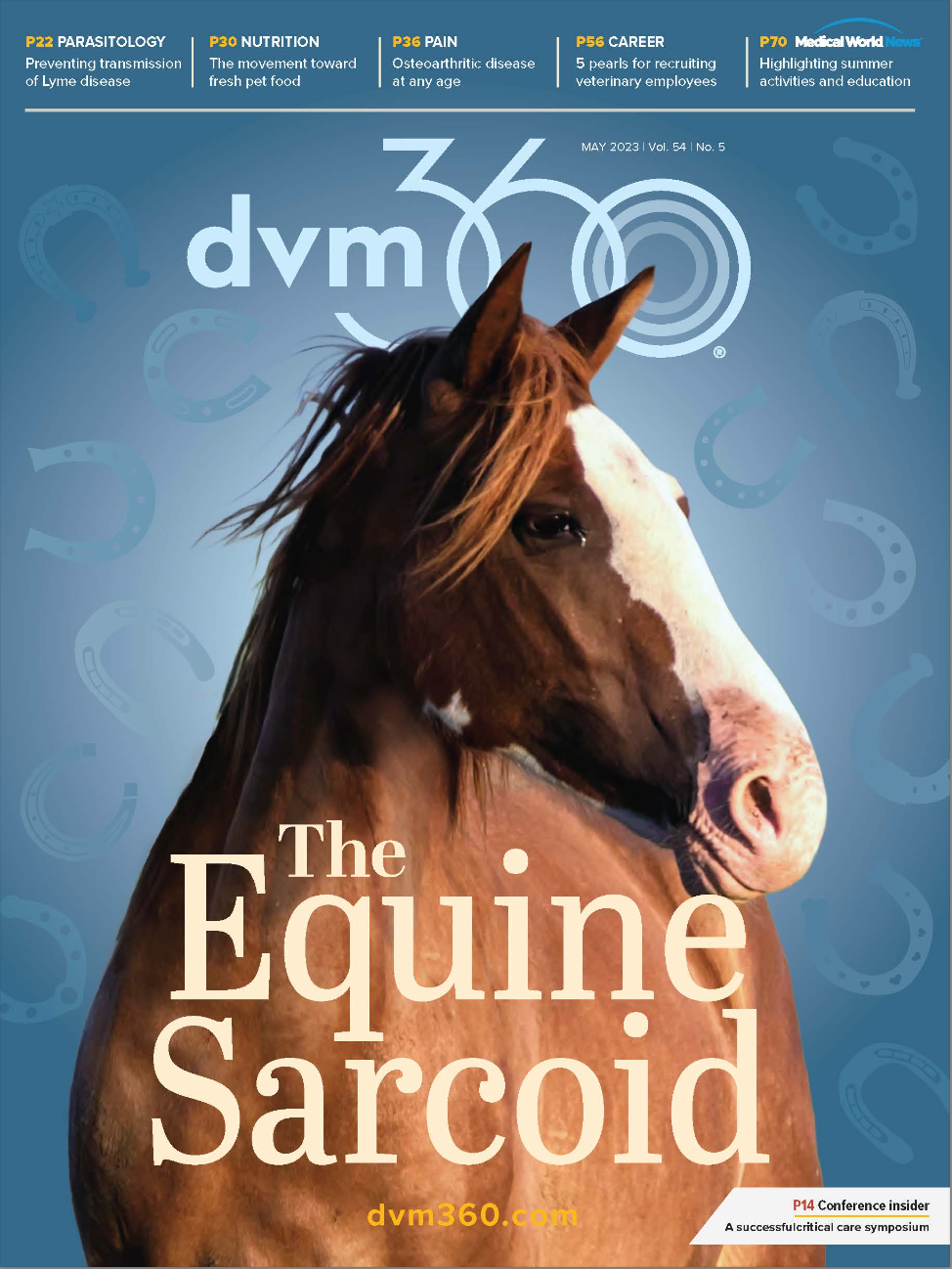Protecting dogs against seasonal infection
Spring is a good time to ensure pets are vaccinated against common diseases
As the temperature rises and furry friends partake in more outdoor adventures, they are at higher risk for certain diseases. This makes spring an ideal time to ensure their vaccines are up to date.
annaav / stock.adobe.com

All dogs should be vaccinated for rabies, which is required by law, and additional vaccine recommendations vary by geographical location, according to Camille Alander-Rivera, DVM, with Bond Vet in Boston, Massachusetts. Some vaccines to keep in mind this spring include those protecting against Lyme disease, leptospirosis, distemper, canine parvovirus (CPV), and kennel cough. Along with protecting pets from the potentially devastating effects of these diseases, vaccinating them protects veterinary professionals, pet owners, and other community members from zoonotic infections.
“We want to make sure we’re lessening the severity of diseases if our pets are coming into contact with them or preventing diseases,” Alander-Rivera explained in a dvm360® interview. “We certainly want to keep our pets healthy for their own well-being, for our well-being, and for the general public’s well-being.” These diseases and their accompanying vaccinations are as follows:
Rabies
Rabies is a year-round concern, although spending more time outside may put dogs at higher risk of exposure to infected animals (eg, raccoons, skunks, foxes, bats) that can scratch or bite them. Anytime a pet comes into this kind of contact with another animal, they should immediately be evaluated by a veterinarian, Kristin Zersen, DVM, DACVECC, assistant professor of small animal emergency and critical care at Colorado State University Veterinary Teaching Hospital, advised in an email to dvm360®. Rabies is estimated to cause 59,000 human deaths annually, with 99% of people acquiring this potentially fatal disease from an infected dog.1
Puppies can be vaccinated for rabies at as young as 12 weeks. Most US regions, depending on state and local laws, require puppies to have the rabies vaccine by aged 4 to 6 months, with the next vaccine administered 1 year later. After this, the rabies vaccine is usually administered about every 1 to 3 years, depending on the vaccine manufacturer, the pet’s age, and state or local laws.2
Lyme disease
Transmitted by infected ticks, Lyme disease has been reported all throughout the US; however it is most common in the upper Midwestern states, East Coast states, and Pacific Coast states, and it has been spreading year to year.3
The vaccine for Lyme disease is often recommended for dogs living in or traveling to areas known for this disease or high potential for tick exposure. The vaccine is first given as a series of 2 boosters, meaning 2 doses are administered 2 to 4 weeks apart; depending on the formulation’s manufacturer, this series can begin around aged 8 to 9 weeks.4 When and how often dogs receive the immunization booster after this will be based on the Lyme disease concern in the area and pet’s risk for tick bites.4
The vaccine doesn’t prevent pets from getting Lyme disease but it can lessen the severity if they contract it. A study found that compared with unvaccinated dogs exposed to Lyme disease, vaccinated dogs had reduced odds of developing lameness, depression, pyrexia, and anorexia.5 The vaccine and year-round flea and tick prevention can serve as proactive measures, according to Alander-Rivera. These measures are critical because though there is no evidence that dogs can spread Lyme disease to humans, they can bring infected ticks into the home.6
Leptospirosis
Leptospirosis is a bacterial infection spread through the urine of infected rodents and other wildlife. It affects dogs exposed to contaminated soil or water. “Urine infected with the bacteria lives on in stagnant water, [including] puddles on the sidewalk, little ponds, little lakes, things like that,” Alander-Rivera explained. “Even if you go around in urban areas, and you see stores have communal dog water bowls out front, the bacteria can infect those as well.”
This potentially fatal disease in dogs can be transmitted to humans as well. The vaccine for leptospirosis is a second-generation formulation that prevents against 4 types of the disease7 and is typically administered annually to maintain optimal immunity.8
CPV, distemper, and kennel cough
A potentially fatal disease affecting the gastrointestinal tract, CPV is mostly spread through exposure to feces from infected dogs, Zersen said. Distemper is also a potentially fatal disease caused by a virus attacking the respiratory, gastrointestinal, and nervous systems.9 Dogs frequently become infected through airborne exposure to the virus from an infected dog or wild animal, though it also can be transmitted through shared food, water bowls, and other equipment.9 Kennel cough is a respiratory disease associated with a dry, hacking cough, nasal discharge, and fever9 and is spread from dog to dog through coughing and sneezing. Dogs often get it in places where they congregate, such as dog parks or boarding facilities, said Alander-Rivera.
A 5-in-1 vaccine protects dogs from CPV, distemper, and kennel cough as well as 2 types of adenovirus (hepatitis), and parainfluenza.10 This combination vaccine is administered to puppies as young as 6 weeks, every 2 to 4 weeks until they reach aged 16 weeks. Dogs older than 16 weeks that have never been vaccinated receive only 1 or 2 initial doses. Dogs receive booster doses every 1 to 3 years, depending on the vaccine manufacturer and veterinarian recommendation.10
Educating clients
The best way to ensure adherence to vaccinations is to educate clients. “Knowledge is power,” Zersen remarked. “Sharing information on the morbidity and mortality associated with these diseases is a great way for owners to obtain the knowledge they need to make an informed decision.”
Alander-Rivera added that veterinary professionals can remind clients to ensure their pets don’t drink from stagnant water and puddles or consume feces. If pet owners notice any symptoms of illness, including decreased appetite, lethargy, soft stool, diarrhea, coughing, or sneezing, they should consult with their veterinarian to learn the best next steps.
References
- Rabies. World Health Organization. Accessed April 13, 2023. https://www.who.int/health-topics/rabies
- McCalley L. Rabies vaccine for dogs. Great Pet Care. Reviewed November 30, 2021. Accessed April 12, 2023. https://www.greatpetcare.com/pet-vaccinations/rabies-vaccine-for-dogs
- Lyme disease in dogs: symptoms and treatment. PetMD. Updated May 2, 2022. Accessed April 12, 2023. https://www.petmd.com/dog/conditions/infectious-parasitic/c_dg_lyme_disease
- Brister J. Lyme disease vaccine for dogs. Embrace Pet Insurance. July 22, 2019. Accessed April 12, 2023. https://www.embracepetinsurance.com/waterbowl/article/lyme-disease-vaccine-dogs
- Vogt NA, Sargeant JM, MacKinnon MC, Versluis AM. Efficacy of Borrelia burgdorferi vaccine in dogs in North America: a systematic review and meta-analysis. J Vet Intern Med. 2019;33(1):23-36. doi:10.1111/jvim.15344
- Lyme disease transmission. Centers for Disease Control and Prevention. January 20, 2023. Accessed April 13, 2023. https://www.cdc.gov/lyme/transmission/index.html
- Leptospirosis: what every dog owner should know. Michigan State University Veterinary Diagnostic Laboratory. Accessed April 12, 2023. https://cvm.msu.edu/vdl/client-education/guides-for-pet-owners/leptospirosis-what-every-dog-owner-should-know
- Weir M, Barnette C, Ward E. Leptospirosis in dogs. VCA Animal Hospitals. Accessed April 12, 2023. https://vcahospitals.com/know-your-pet/leptospirosis-in-dogs
- Canine distemper. American Veterinary Medical Association. Accessed April 12, 2023. https://www.avma.org/resources/pet-owners/petcare/canine-distemper
- Stilwell N. What is the DHPP vaccine (5-in-1 vaccine) for dogs? PetMD. June 12, 2019. Accessed April 13, 2023. https://www.petmd.com/dog/care/what-5-1-vaccine-dogs
